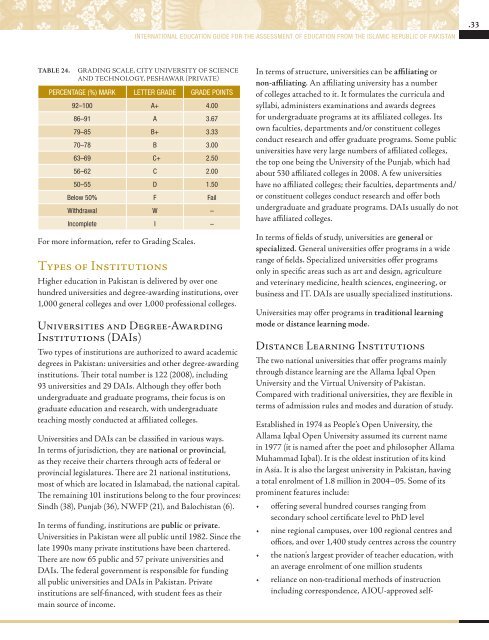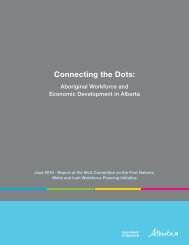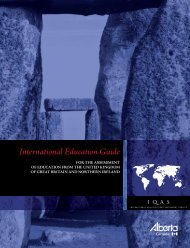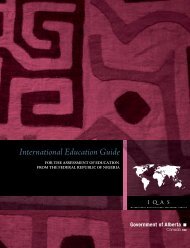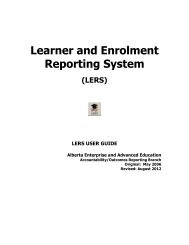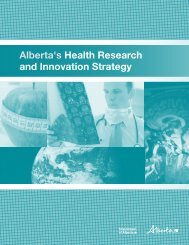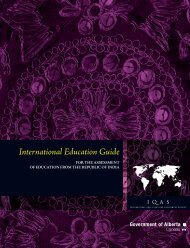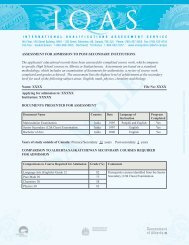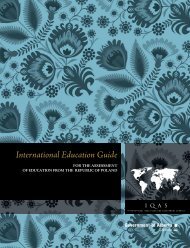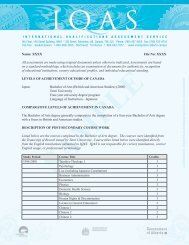International Education Guide - Enterprise and Advanced Education ...
International Education Guide - Enterprise and Advanced Education ...
International Education Guide - Enterprise and Advanced Education ...
You also want an ePaper? Increase the reach of your titles
YUMPU automatically turns print PDFs into web optimized ePapers that Google loves.
INTERNATIONAL EDUCATION GUIDE for the assessment of education from the Islamic Republic of Pakistan<br />
.33<br />
Table 24.<br />
Grading Scale, City University of Science<br />
<strong>and</strong> Technology, Peshawar (Private)<br />
Percentage (%) Mark Letter Grade Grade Points<br />
92–100 A+ 4.00<br />
86–91 A 3.67<br />
79–85 B+ 3.33<br />
70–78 B 3.00<br />
63–69 C+ 2.50<br />
56–62 C 2.00<br />
50–55 D 1.50<br />
Below 50% F Fail<br />
Withdrawal W –<br />
Incomplete I –<br />
For more information, refer to Grading Scales.<br />
Types of Institutions<br />
Higher education in Pakistan is delivered by over one<br />
hundred universities <strong>and</strong> degree-awarding institutions, over<br />
1,000 general colleges <strong>and</strong> over 1,000 professional colleges.<br />
Universities <strong>and</strong> Degree-Awarding<br />
Institutions (DAIs)<br />
Two types of institutions are authorized to award academic<br />
degrees in Pakistan: universities <strong>and</strong> other degree-awarding<br />
institutions. Their total number is 122 (2008), including<br />
93 universities <strong>and</strong> 29 DAIs. Although they offer both<br />
undergraduate <strong>and</strong> graduate programs, their focus is on<br />
graduate education <strong>and</strong> research, with undergraduate<br />
teaching mostly conducted at affiliated colleges.<br />
Universities <strong>and</strong> DAIs can be classified in various ways.<br />
In terms of jurisdiction, they are national or provincial,<br />
as they receive their charters through acts of federal or<br />
provincial legislatures. There are 21 national institutions,<br />
most of which are located in Islamabad, the national capital.<br />
The remaining 101 institutions belong to the four provinces:<br />
Sindh (38), Punjab (36), NWFP (21), <strong>and</strong> Balochistan (6).<br />
In terms of funding, institutions are public or private.<br />
Universities in Pakistan were all public until 1982. Since the<br />
late 1990s many private institutions have been chartered.<br />
There are now 65 public <strong>and</strong> 57 private universities <strong>and</strong><br />
DAIs. The federal government is responsible for funding<br />
all public universities <strong>and</strong> DAIs in Pakistan. Private<br />
institutions are self-financed, with student fees as their<br />
main source of income.<br />
In terms of structure, universities can be affiliating or<br />
non-affiliating. An affiliating university has a number<br />
of colleges attached to it. It formulates the curricula <strong>and</strong><br />
syllabi, administers examinations <strong>and</strong> awards degrees<br />
for undergraduate programs at its affiliated colleges. Its<br />
own faculties, departments <strong>and</strong>/or constituent colleges<br />
conduct research <strong>and</strong> offer graduate programs. Some public<br />
universities have very large numbers of affiliated colleges,<br />
the top one being the University of the Punjab, which had<br />
about 530 affiliated colleges in 2008. A few universities<br />
have no affiliated colleges; their faculties, departments <strong>and</strong>/<br />
or constituent colleges conduct research <strong>and</strong> offer both<br />
undergraduate <strong>and</strong> graduate programs. DAIs usually do not<br />
have affiliated colleges.<br />
In terms of fields of study, universities are general or<br />
specialized. General universities offer programs in a wide<br />
range of fields. Specialized universities offer programs<br />
only in specific areas such as art <strong>and</strong> design, agriculture<br />
<strong>and</strong> veterinary medicine, health sciences, engineering, or<br />
business <strong>and</strong> IT. DAIs are usually specialized institutions.<br />
Universities may offer programs in traditional learning<br />
mode or distance learning mode.<br />
Distance Learning Institutions<br />
The two national universities that offer programs mainly<br />
through distance learning are the Allama Iqbal Open<br />
University <strong>and</strong> the Virtual University of Pakistan.<br />
Compared with traditional universities, they are flexible in<br />
terms of admission rules <strong>and</strong> modes <strong>and</strong> duration of study.<br />
Established in 1974 as People’s Open University, the<br />
Allama Iqbal Open University assumed its current name<br />
in 1977 (it is named after the poet <strong>and</strong> philosopher Allama<br />
Muhammad Iqbal). It is the oldest institution of its kind<br />
in Asia. It is also the largest university in Pakistan, having<br />
a total enrolment of 1.8 million in 2004–05. Some of its<br />
prominent features include:<br />
• offering several hundred courses ranging from<br />
secondary school certificate level to PhD level<br />
• nine regional campuses, over 100 regional centres <strong>and</strong><br />
offices, <strong>and</strong> over 1,400 study centres across the country<br />
• the nation’s largest provider of teacher education, with<br />
an average enrolment of one million students<br />
• reliance on non-traditional methods of instruction<br />
including correspondence, AIOU-approved self-


